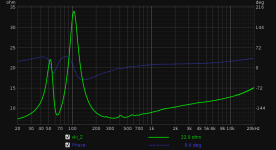
Darn it, Fb is lower than I desired by 10Hz. I kept a provision to add length to my vent, but shortening it will mean some in-situ hacking-off. I'll wait until I've measured and listened to see if this is necessary though. I may have underestimated both rear and front bends' contribution on effective length. A higher and faster aperture might bring the rear tuning up a bit though and I do intend to make one.
I never got around to simplifying/fine tuning the horn flare calculator I did ages ago that ya'll had such a hard time with, but in retrospect it seems reasonable it can be reduced to the same as a horn in theory, so a 1" wide throat gap = ~13543/pi/1 = 4310 Hz and just assuming a 13" terminus = ~331.6 Hz = flare frequency with a mean = sqrt(4310*331.6) = 1195.5 Hz, i.e. where it 'rings', hence a horn's rear chamber (Fc) if reactance annulling, so the HF tuning point, which seems a good place for an XO point like in a regular multi-way speaker or where a whizzer takes over, so could design around this and the flare frequency and reverse engineer to get the rest of it.probably due to my terribly poor drawing, the aperture gap appears to be wider (?) than the one inch draw. That may be helpful in learning and seeing where it tunes, plus could be a "best" aperture.
With what ya'll now know about designing these, 'whatcha' think?
sounds reasonable - if I can quit nodding off for awhile then will see if 1/4"-20 screws will fit into a K12H-200TC frame and line up
Last edited:
That’s happened to me in this design as well. It must be the corners of the vent. I had to cut over an inch off my earlier foam core one for the Beta 8CX. On my W5-2143 I got it right though by keeping the corners clear and adding a round over to the vent entrance inside.View attachment 1007439
Darn it, Fb is lower than I desired by 10Hz. I kept a provision to add length to my vent, but shortening it will mean some in-situ hacking-off. I'll wait until I've measured and listened to see if this is necessary though. I may have underestimated both rear and front bends' contribution on effective length. A higher and faster aperture might bring the rear tuning up a bit though and I do intend to make one.
Yeah, mine tuned quite a bit lower than the sim.View attachment 1007439
Darn it, Fb is lower than I desired by 10Hz. I kept a provision to add length to my vent, but shortening it will mean some in-situ hacking-off. I'll wait until I've measured and listened to see if this is necessary though. I may have underestimated both rear and front bends' contribution on effective length. A higher and faster aperture might bring the rear tuning up a bit though and I do intend to make one.
I have yet to measure FR and only managed a quick listen so far (not bad, more on that later), but I think the 65Hz tuning isn't that bad, afterall, it's 70Hz on the 9L DCR.
I got to take some measurements. I have two W4-1320SIF, with very closely matched T/S parameters, one in the XKi, the other in a 9L net Vb Double-Chamber Reflex (DCR). Here is their frequency response at 34cm, where the mic could be on-axis for both enclosure configurations.
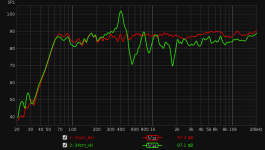
The bass hump below 100Hz shows that both enclosures are on the large side for this driver. I knew this going into the XKi, but had assumed factory specs when making the DCR, whereas my drivers actually exhibit a lower Vas and higher Qts. They still do well in the DCR, so I still went for the large Vb on the XKi to help reach a bit lower. I think I should have gone smaller and tune higher. The XKi does have good bass, but its efficiency over the band-pass bandwidth is no higher than the DCR, save for the sharp cavity peak at 400Hz and has the midrange warts and associated colouration.
The XKi's response above 2kHz isn't bad at all. The on-axis output is lower than the DCR, but I believe that would be the K-slot diffraction spreading out the energy for a broader power response. The effect isn't as prominent around 15kHz and above, where the K-slot gets wider than the wavelength on the driver's axis intercept. The K-slot can thus somewhat help with baffle-step. Note that there hardly is any step on the DCR, where it should be around 515Hz and IMO measurable 34cm away.
I may consider either filling-up some volume in the rear chamber or simply hacking-off 1 or 2 inches of cabinet depth on the table saw to try and give it a bit of an edge somewhere over the direct-radiating DCR.
I do have to say, my previous experience with a Karlson of comparable size was a K5, which I recall had similar height and width, but was much shallower. It sounded quite frankly pretty bad. I never thought much about small K's afterwards, perhaps unless high-aspect, preferring to stick to 8" and up. Even then, my 8" SK8 was almost a K10 going by classic scale-down from K15. So that this fairly small Karlson is listenable at all is pretty good! Perhaps I can tame some of the response issues. For some reason I've never used any damping in the front chamber, but it might be nigh-unavoidable when getting this small.
I did take some more measurements, but I won't get into analyzing the response peaks and dips here as I have another thread for this. I did mostly build this XKi as a comparative tool.

The bass hump below 100Hz shows that both enclosures are on the large side for this driver. I knew this going into the XKi, but had assumed factory specs when making the DCR, whereas my drivers actually exhibit a lower Vas and higher Qts. They still do well in the DCR, so I still went for the large Vb on the XKi to help reach a bit lower. I think I should have gone smaller and tune higher. The XKi does have good bass, but its efficiency over the band-pass bandwidth is no higher than the DCR, save for the sharp cavity peak at 400Hz and has the midrange warts and associated colouration.
The XKi's response above 2kHz isn't bad at all. The on-axis output is lower than the DCR, but I believe that would be the K-slot diffraction spreading out the energy for a broader power response. The effect isn't as prominent around 15kHz and above, where the K-slot gets wider than the wavelength on the driver's axis intercept. The K-slot can thus somewhat help with baffle-step. Note that there hardly is any step on the DCR, where it should be around 515Hz and IMO measurable 34cm away.
I may consider either filling-up some volume in the rear chamber or simply hacking-off 1 or 2 inches of cabinet depth on the table saw to try and give it a bit of an edge somewhere over the direct-radiating DCR.
I do have to say, my previous experience with a Karlson of comparable size was a K5, which I recall had similar height and width, but was much shallower. It sounded quite frankly pretty bad. I never thought much about small K's afterwards, perhaps unless high-aspect, preferring to stick to 8" and up. Even then, my 8" SK8 was almost a K10 going by classic scale-down from K15. So that this fairly small Karlson is listenable at all is pretty good! Perhaps I can tame some of the response issues. For some reason I've never used any damping in the front chamber, but it might be nigh-unavoidable when getting this small.
I did take some more measurements, but I won't get into analyzing the response peaks and dips here as I have another thread for this. I did mostly build this XKi as a comparative tool.
Hi IG81,
That’s not a bad measurement for a K! That big peak at 400Hz might be tamed with some damping in the front chamber. I use melamine foam sponges on side walls. I also line the inside of K aperture with foam core and felt.
Tangbands seem to do well in this box though. Tennis balls might work to use up some rear chamber volume?
That’s not a bad measurement for a K! That big peak at 400Hz might be tamed with some damping in the front chamber. I use melamine foam sponges on side walls. I also line the inside of K aperture with foam core and felt.
Tangbands seem to do well in this box though. Tennis balls might work to use up some rear chamber volume?
The 400Hz peak is indeed a front chamber effect, it goes away if the wing panel is removed, as also seen on my TK6 in the analysis thread. Absorption would indeed help.
Sure it's not a slot eigenmode, which among other response anomalies could be tamed/smoothed by critically damping it like the vent it is?
GM,
I'm a few days late replying to your comment. Damping via grille cloth maybe? I think it is something your have suggested several times in the past IIRC.
I tried a simple thin fabric to start, think Dynaco A25, which I did use to restore a pair several years back. I then went a bit more extreme to a microfiber cloth, thicker and towel-like. Here are impedance and SPL response plot, taken 12" away for the latter. Green is no grille, red the simple fabric, blue microfiber.
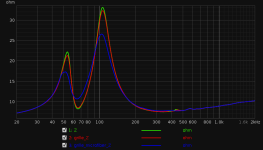
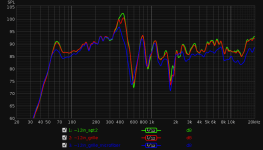
There is a significant damping of the front chamber resonance peak. While I expected some reduction of LF SPL since the aperture is the final vent of the system, it went down more than I though it would.
I also made a new aperture, which starts a bit higher and has a more open profile, radius of 27". This increased the frequency of the front chamber peak, see the below graph.
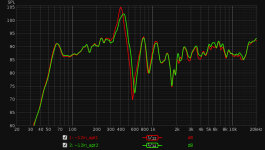
I think overall, for my specific XKi, not the general design, the issues are as follow:
I'm a few days late replying to your comment. Damping via grille cloth maybe? I think it is something your have suggested several times in the past IIRC.
I tried a simple thin fabric to start, think Dynaco A25, which I did use to restore a pair several years back. I then went a bit more extreme to a microfiber cloth, thicker and towel-like. Here are impedance and SPL response plot, taken 12" away for the latter. Green is no grille, red the simple fabric, blue microfiber.


There is a significant damping of the front chamber resonance peak. While I expected some reduction of LF SPL since the aperture is the final vent of the system, it went down more than I though it would.
I also made a new aperture, which starts a bit higher and has a more open profile, radius of 27". This increased the frequency of the front chamber peak, see the below graph.

I think overall, for my specific XKi, not the general design, the issues are as follow:
- The tunings are too far apart and do not result in useful gain over 2 to 2.5 octaves. The rear chamber should be smaller, tuned higher at the very least.
- The small size of the front chamber forces a fairly sharp and high frequency peak (~400-450Hz in mine), too far away from the rear chamber tuning.
- It provides very little over the direct-radiating driver, see a few post up for measurements. Perhaps only a BSC-like effect via slot HF dispersion.
Last edited:
I went ahead and truncated the XKi rear chamber, cutting-off 2" of the back chamber, bringing its volume from ~8L to 5.5L. That was easy enough on the table saw. I first cut off the rear-most section with back-panel cleats and glued it back on. The vent was now really restricted at the back so i just took off about 0.375" with the router. It turned out to tune at 85Hz, pretty much what I was going for, good guesstimating!
Here a nearslot and ~12" away responses for the 8L back versus 5.5L back, with the newest r=27" aperture. Green is 5.5L, red 8L. I played with and 'lost' my VC setting on my amp in-between, so normalized the two traces at 200Hz.
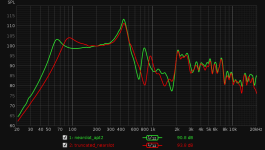
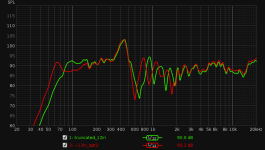
The smaller Vb and higher tuning make for a smoother LF response and provides more power in the ~100Hz region, where a 4" driver can probably do better compared to trying to extract much below 70Hz. The front cavity peak remains unchanged, but the null and peaks from 500Hz to 2kHz are shifted up. There is little effect above 2kHz.
Here a nearslot and ~12" away responses for the 8L back versus 5.5L back, with the newest r=27" aperture. Green is 5.5L, red 8L. I played with and 'lost' my VC setting on my amp in-between, so normalized the two traces at 200Hz.


The smaller Vb and higher tuning make for a smoother LF response and provides more power in the ~100Hz region, where a 4" driver can probably do better compared to trying to extract much below 70Hz. The front cavity peak remains unchanged, but the null and peaks from 500Hz to 2kHz are shifted up. There is little effect above 2kHz.
Here is the compared response of the 5.5L XKi and DCR, with sister driver.
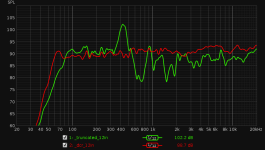
I now have a bit of gain from 80Hz to 500Hz, though it might be questionable to count the 12dB peak at 425Hz. This is IMO better than my original XKi build, whose comparative measurement can be found in post #1327.
Here's something I have never tried on a Karlson, an absorber for troublesome peaks. Here it is at 425Hz, so I've rolled up an 8" length of thin cardboard around a 1" dowel, held with tape and caped-off one end. I simply placed it "freestanding" in the front chamber, with the open end at the top of the chamber.
The red trace is with absorber in place.
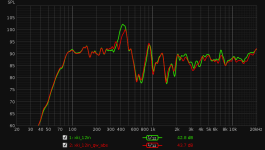
There is some measurable effect, not bad. I suppose a larger diameter tube placed more strategically might have a worthwhile effect.

I now have a bit of gain from 80Hz to 500Hz, though it might be questionable to count the 12dB peak at 425Hz. This is IMO better than my original XKi build, whose comparative measurement can be found in post #1327.
Here's something I have never tried on a Karlson, an absorber for troublesome peaks. Here it is at 425Hz, so I've rolled up an 8" length of thin cardboard around a 1" dowel, held with tape and caped-off one end. I simply placed it "freestanding" in the front chamber, with the open end at the top of the chamber.
The red trace is with absorber in place.

There is some measurable effect, not bad. I suppose a larger diameter tube placed more strategically might have a worthwhile effect.
Stuff the tube with absorbent, erm, stuff. If it'll fit, make another tube. If it doesn't, you might be able to make a helmholtz thing with more volume and smaller entry. FWIW.
Grindstone,
I may try a larger tube in the rear chamber, coupled through the "reflector" panel; I'll surely try stuffing it if I do so. I don't know whether a QW or Helmoltz would be more space-efficient, but the rear chamber could still stand to lose a half liter or so IMO.
I may try a larger tube in the rear chamber, coupled through the "reflector" panel; I'll surely try stuffing it if I do so. I don't know whether a QW or Helmoltz would be more space-efficient, but the rear chamber could still stand to lose a half liter or so IMO.
1/4-wave stub absorbers work well. I have often added these in my simulations and they can work wonders on circa 400Hz peaks. Stuff them with fiberglass etc though.
Hi xrk971,Plans for XKi with W5-2143
I have received numerous requests for the plans for this speaker and I think it is out there in various versions. However, I never really had a plan that was more than the written description of the internal box dimensions and vent size. Here is a sketch of the one that I have as-built. There is a sketchup file somewhere by my cabinet maker, but I think no "2D Plans" anywhere. If someone has 2D CAD plans already, please post here or show us the link,
Here is my hand sketched plan that contains evertthing you need to build it. Dimensions are in inches and point to important inside dimensions. The assumption here is that it can be made of anything from 3/16in foam core to 3/4in BB ply - just maintain the internal dimensions. I think 1/2in BB ply is a good one to use for this size box. The notes on the lining with foam/felt pads and lining the rear of aperture with foamcore and felt are important to follow unless you are making a foamcore box, in which case just add some melamine pads where inidcated. A BSC is probably a good idea - and a basic one is provided. The aperture can be hand drawn/cut based on dimensions shown (about 2in from top is a 1/4in notch slowly cunrving downwards to a 1/4in to 1/2in wide flat at the bottom of the aperture.
It is a great sounding speaker - with bass extension and punch well beyond its size would indicate. And being 90dB sensitive, can get quite loud with just a few watts of power.

PDF version also attached below.
I hope this is useful and more folks make this excellent sounding speaker.
I'm interested in buying the W5-2143, and I have a question about the BSC circuit. Is it really required? I will use it with a 3.5W tube amp.
Thanks, brillant discussion!!!
It’s needed if you like bass to sound balanced with highs. Some people like a brighter sound. Also, if you place speaker near rear wall, that reinforces the bass and you may not need it. So it might be optional depending on placement and taste.
I have no option... It will be on the wood rack I have in the living room (almost 6' wide, 1.5' deep).It’s needed if you like bass to sound balanced with highs. Some people like a brighter sound. Also, if you place speaker near rear wall, that reinforces the bass and you may not need it. So it might be optional depending on placement and taste.
I think I will add the BSC only if needed. Thanks for the answer!!!
- Home
- Loudspeakers
- Full Range
- XKi - X's ab initio Karlson 6th Order Bandpass